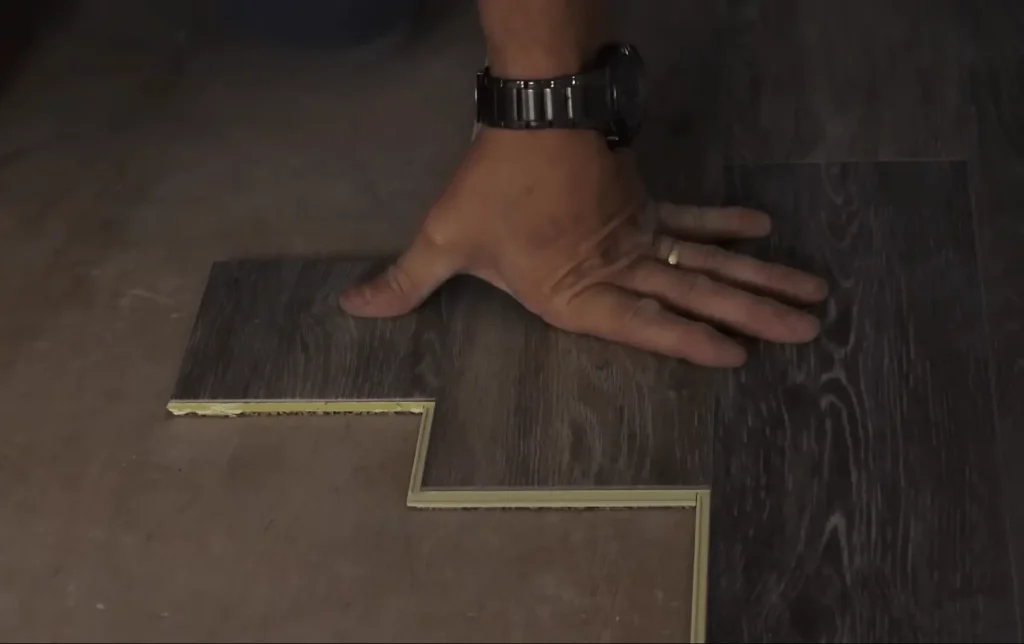How to Stagger Vinyl Plank Flooring: A Complete DIY Guide
Vinyl plank flooring has become a favorite choice among homeowners for its durability, aesthetic appeal, and ease of installation.
Whether you’re tackling a home renovation or updating a single room, vinyl plank flooring offers a practical and stylish solution.
One crucial aspect of installing this type of flooring is ensuring the planks are staggered correctly.
Staggering not only enhances the visual appeal but also ensures the stability and longevity of the floor.
To stagger vinyl plank flooring, start by cutting the first plank of each new row to a different length, ensuring the seams are at least 6 inches apart. This staggered pattern enhances stability and creates a more natural look. Continue this process, alternating plank lengths to avoid alignment issues and maintain a professional appearance.
In this guide, we’ll walk you through everything you need about how to stagger vinyl plank flooring, from preparation to execution.
What is Vinyl Plank Flooring?
Vinyl plank flooring is a versatile and resilient option that mimics hardwood’s look.
It’s made from multiple layers of vinyl, making it water-resistant and highly durable.
This type of flooring is available in various styles, colors, and textures, allowing you to choose the perfect look for your space.
One of the significant benefits of vinyl plank flooring is its ease of installation. Many products come with a click-and-lock system, meaning you can install them as a floating floor without needing adhesives.
This feature makes it an excellent choice for DIY enthusiasts. Additionally, vinyl plank flooring is relatively low maintenance, requiring only regular sweeping and occasional mopping to keep it looking its best.
Why Staggering Vinyl Plank Flooring is Important

Staggering vinyl plank flooring isn’t just about aesthetics; it’s a vital step to ensure the floor’s structural integrity and longevity.
By staggering the planks, you create a more stable surface that can better withstand daily wear and tear.
When planks are staggered, the seams between them are distributed more evenly across the floor, reducing the risk of alignment issues and weak spots.
This distribution helps prevent problems like gaps and buckling, which can occur if the planks are not installed correctly.
Moreover, a staggered pattern enhances the visual appeal of the floor. It creates a more natural and random look, similar to traditional hardwood floors, adding to the overall charm and sophistication of your space.
Proper staggering also ensures that the ends of the planks are less likely to line up, which can create unsightly seams and diminish the aesthetic value.
Tools and Materials Needed
Before you start installing your vinyl plank flooring, gather all the necessary tools and materials. Having everything ready will make the process smoother and more efficient.
Essential tools include a tape measure, utility knife, and straight edge.
These will help you measure and cut the planks accurately. You’ll also need a pencil for marking cuts and a rubber mallet for tapping the planks into place.
For the materials, you’ll need your vinyl planks and possibly underlayment, depending on the product and the subfloor condition. Underlayment can help with sound absorption and provide a smoother surface for the planks.
Optional tools that can make the job easier include spacers to maintain expansion gaps around the room’s perimeter and a tapping block to help secure the planks without damaging them.
These tools are particularly useful for ensuring a snug fit and professional finish.
Preparing Your Floor
Proper preparation is key to a successful vinyl plank flooring installation.
Start by assessing the condition of your subfloor. It should be clean, dry, and level. Any imperfections can affect the installation and the floor’s durability.
Clean the subfloor thoroughly to remove any dust, dirt, or debris. This step ensures that the vinyl planks adhere properly and lie flat. If necessary, repair any damage or uneven areas before proceeding.
Next, consider laying an underlayment. While not always required, underlayment can provide additional cushioning, sound absorption, and moisture protection. It’s particularly beneficial if you’re installing the flooring over concrete or an uneven surface.
Measure the room carefully to determine the layout and the number of planks needed. Plan the installation so that the final row is at least half a plank wide.
This planning helps avoid having to cut narrow strips, which can be tricky to install and less stable.
Step-by-Step Guide How to Stagger Vinyl Plank Flooring
Step 1: Laying the First Row
Begin in a corner of the room, laying the first row of planks along the longest wall.
Ensure the first plank is straight and even, as this will set the foundation for the entire floor.
Use spacers to maintain an expansion gap of about 1/4 inch between the planks and the wall.
This gap allows the floor to expand and contract with changes in temperature and humidity.
Step 2: Cutting the First Plank of the Second Row
To create a staggered effect, cut the first plank of the second row to a different length. This step is crucial to avoid aligning the seams of adjacent rows, which can weaken the floor.
Ideally, the ends of the planks in adjacent rows should be at least 6 inches apart.
Use a utility knife and a straight edge to make precise cuts. Always measure twice and cut once to avoid mistakes.
Step 3: Continuing the Installation
Continue laying the planks, ensuring each new row starts with a plank cut to a different length than the previous row.
This staggered pattern should be varied enough to look random and natural.
Use the tapping block and rubber mallet to secure the planks, ensuring they click together firmly. Periodically check for straight lines and alignment to maintain a professional look.
Step 4: Finishing the Installation
As you approach the final rows, you may need to trim the planks to fit.
Measure carefully and cut the planks to size, maintaining the expansion gap around the perimeter.
The last row might require some adjustment to fit snugly against the wall. Use a pull bar to secure the final planks without damaging them.
Tips for a Professional-Looking Stagger
To achieve a professional-looking staggered pattern, avoid creating a repeating pattern. Instead, aim for a random, natural look by varying the lengths of the starting planks in each row.
This approach not only enhances the visual appeal but also increases the floor’s stability.
Ensure that the ends of the planks are at least 6 inches apart. This distance helps distribute the weight and movement more evenly across the floor, reducing the risk of gaps and alignment issues.
Periodically check your work to ensure the planks are straight and the seams are tight.
Additionally, take your time and don’t rush the process. Precision is key to achieving a flawless finish. If you encounter any issues, such as a plank that doesn’t fit perfectly, don’t hesitate to remove it and try again. Attention to detail will pay off in the final result.
Common Mistakes to Avoid
When installing vinyl plank flooring, there are a few common mistakes to watch out for.
Avoid using the same length for each row, as this can create a repetitive pattern and weaken the floor’s structure.
Instead, vary the lengths of the starting planks to achieve a random, natural look.
Not accounting for expansion gaps is another common mistake. Vinyl plank flooring expands and contracts with changes in temperature and humidity. Failing to leave a 1/4 inch gap around the room’s perimeter can cause the floor to buckle or warp over time.
Before installation, inspect each plank for defects. Installing damaged planks can compromise the floor’s appearance and durability. If you find any planks with imperfections, set them aside and use them for cuts or less visible areas.
Conclusion
Staggering vinyl plank flooring might seem like a challenging task, but with the right tools, materials, and a bit of patience, you can achieve a stunning and durable floor.
By following the steps outlined in this guide and taking the time to plan and execute the installation carefully, you’ll create a beautiful, professional-looking floor that enhances the overall appeal of your space.
Remember, attention to detail is key. Take your time, measure accurately, and ensure each plank fits snugly. If you found this guide helpful, don’t forget to share it with others and subscribe for more home improvement tips and tricks.
Frequently Asked Questions (FAQs)
Related Articles:
- Which Direction to Lay Vinyl Plank Flooring? Expert Tips
- What is a Floor Joist? Types, Materials, and Installation

